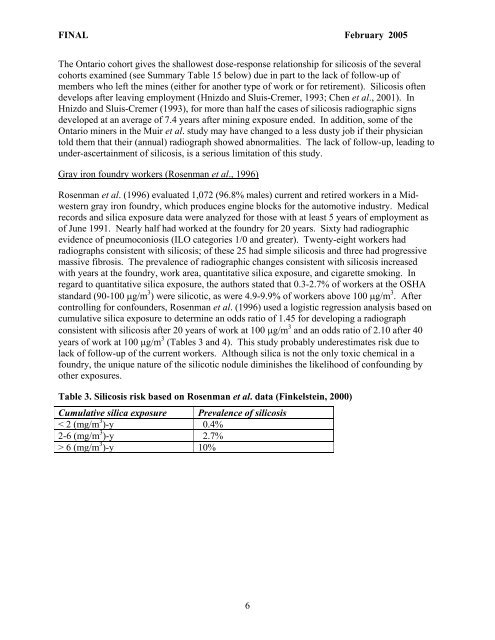Silica (crystalline, respirable) - OEHHA
Silica (crystalline, respirable) - OEHHA
Silica (crystalline, respirable) - OEHHA
You also want an ePaper? Increase the reach of your titles
YUMPU automatically turns print PDFs into web optimized ePapers that Google loves.
FINAL February 2005<br />
The Ontario cohort gives the shallowest dose-response relationship for silicosis of the several<br />
cohorts examined (see Summary Table 15 below) due in part to the lack of follow-up of<br />
members who left the mines (either for another type of work or for retirement). Silicosis often<br />
develops after leaving employment (Hnizdo and Sluis-Cremer, 1993; Chen et al., 2001). In<br />
Hnizdo and Sluis-Cremer (1993), for more than half the cases of silicosis radiographic signs<br />
developed at an average of 7.4 years after mining exposure ended. In addition, some of the<br />
Ontario miners in the Muir et al. study may have changed to a less dusty job if their physician<br />
told them that their (annual) radiograph showed abnormalities. The lack of follow-up, leading to<br />
under-ascertainment of silicosis, is a serious limitation of this study.<br />
Gray iron foundry workers (Rosenman et al., 1996)<br />
Rosenman et al. (1996) evaluated 1,072 (96.8% males) current and retired workers in a Midwestern<br />
gray iron foundry, which produces engine blocks for the automotive industry. Medical<br />
records and silica exposure data were analyzed for those with at least 5 years of employment as<br />
of June 1991. Nearly half had worked at the foundry for 20 years. Sixty had radiographic<br />
evidence of pneumoconiosis (ILO categories 1/0 and greater). Twenty-eight workers had<br />
radiographs consistent with silicosis; of these 25 had simple silicosis and three had progressive<br />
massive fibrosis. The prevalence of radiographic changes consistent with silicosis increased<br />
with years at the foundry, work area, quantitative silica exposure, and cigarette smoking. In<br />
regard to quantitative silica exposure, the authors stated that 0.3-2.7% of workers at the OSHA<br />
standard (90-100 µg/m 3 ) were silicotic, as were 4.9-9.9% of workers above 100 µg/m 3 . After<br />
controlling for confounders, Rosenman et al. (1996) used a logistic regression analysis based on<br />
cumulative silica exposure to determine an odds ratio of 1.45 for developing a radiograph<br />
consistent with silicosis after 20 years of work at 100 µg/m 3 and an odds ratio of 2.10 after 40<br />
years of work at 100 µg/m 3 (Tables 3 and 4). This study probably underestimates risk due to<br />
lack of follow-up of the current workers. Although silica is not the only toxic chemical in a<br />
foundry, the unique nature of the silicotic nodule diminishes the likelihood of confounding by<br />
other exposures.<br />
Table 3. Silicosis risk based on Rosenman et al. data (Finkelstein, 2000)<br />
Cumulative silica exposure Prevalence of silicosis<br />
< 2 (mg/m 3 )-y 0.4%<br />
2-6 (mg/m 3 )-y 2.7%<br />
> 6 (mg/m 3 )-y 10%<br />
6















